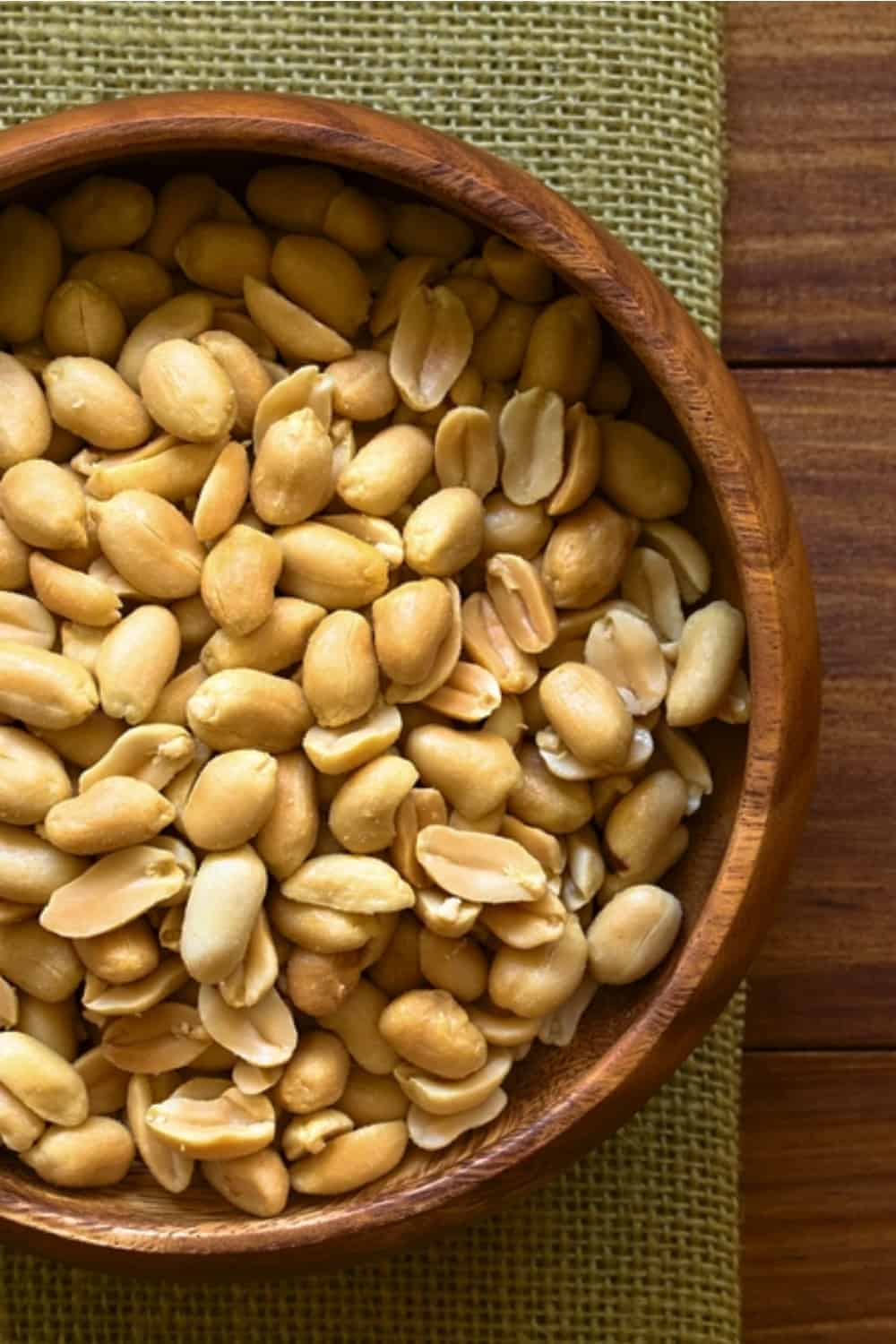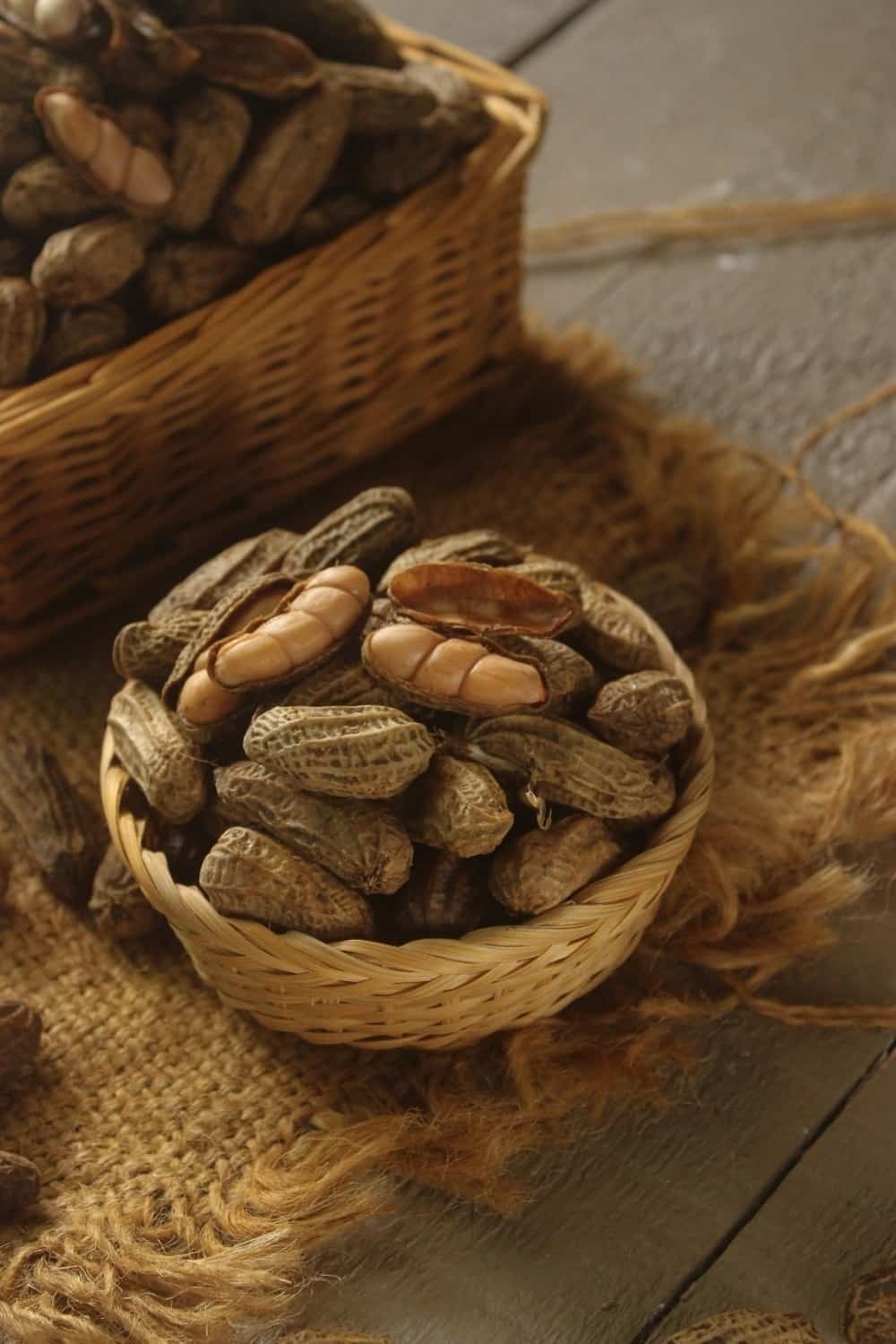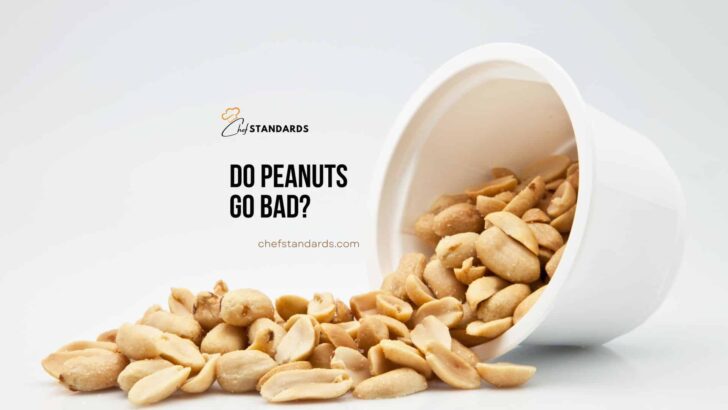Did you know that peanuts are actually legumes? Yes, one of our favorite “nuts” are not nuts in nature, but they are classified in the nuts and seeds category by “USDA Dietary Guidelines for Americans”. If interested, here are more myths about peanuts.
This is because they share so many similarities with nuts, such as their shape, size, nutritional value, flavor profile, and even shelf life and storage traits.
But what are the exact shelf life and storage traits of peanuts? We know that they are quite shelf stable if you know how to handle and store them properly, but can peanuts go bad?
In general, yes, peanuts can go bad, but they won’t spoil in a traditional way, like most other foods.
What does this mean? This article aims to reveal the secrets.
So Can Peanuts Go Bad?

Sometimes, it can be very difficult to define the term “go bad”. In most cases, it is a term that refers to harmful bacteria growth that can cause food poisoning or foodborne illnesses.
However, that term can also be used when talking about mold, pest growth, or even when the food loses its quality, mostly in terms of flavor and texture.
In this particular case, there is a very low chance that peanuts will get contaminated by harmful bacteria, especially if you store them properly.
There is also a low risk of mold or pest growth, but it can happen as a result of bad storage conditions.
Then what can happen to peanuts? Well, they can go rancid. Since peanuts have a high-fat content, i.e. a high oil content, those natural oils are prone to oxidation after some time.
When this happens, your peanuts go rancid or become stale, and that may affect, to some extent, their flavor, texture, and aroma.
So, it is important to know what the exact signs of bad or rancid peanuts are, so continue reading to find out.
How To Tell If Peanuts Have Gone Bad or Rancid?
As I already said, there is a high probability that your peanuts will go rancid. So first, I will show you a few major signs of rancid peanuts.
Rancid Peanuts
Rancidity happens when you let your peanuts stay out or in suboptimal conditions for too long. If this happens, it is very important to make a quick inspection and check for these signs:
• Off Smell: If your peanuts have a chemical (paint-like) or sour smell, they are most likely rancid.
• Bad Taste: Taste is also affected by rancidity. If you give it a taste and you experience a sharp, bitter, or sour flavor, your peanuts are surely rancid.
• Texture Changes: Rancid peanuts often become soft, chewy, or rubbery in texture. They lose their desirable crunchiness and may feel overly oily or greasy.
Bad Peanuts In a More Traditional Way
When you think about it in a statistical or mathematical way, there is about an 80% chance that peanuts will go rancid, and about 20% that they will develop mold or bug growth. But when there is only a slight chance, it is important to be careful.
• Mold Growth: If you do not store peanuts correctly, there is a higher chance that they will develop mold. This is mostly because moisture comes in easily and we all know how much mold spores love moist environments.
Mold appears as fuzzy or powdery patches, usually green, blue, or white in color. So if you see any of these, get rid of those peanuts because consuming mold can cause some health issues.
• Bug Growth: It is even more unlikely that you will find bugs in a bag of peanuts, but it can happen, especially if you do not store them the right way.
Namely, they are an inexhaustible source of undesirable organisms, including bacteria. So even if there is a low chance that peanuts by themselves are unlikely to develop harmful bacteria, they can easily get bugs.
So, if you see any of those nasty insects, toss them and clean the bag or pantry as soon as possible, as these awful creatures spread like wildfire.
What If You Eat Rancid Peanuts?
Although it sounds quite nasty, eating rancid peanuts actually won’t do any significant harm, especially if you eat just a few.
This is especially the case if your peanuts are in an early stage of rancidity. Namely, rancidity is a process, and in its earliest stages, it is very difficult to even recognize it, as the signs are minor.
In this stage, even if you eat a little more of those peanuts, there isn’t a big chance that they will do any harm.
As time goes on, the signs become clearer, i.e., the taste and smell become more sour and the texture changes significantly.
You will probably notice these signs, and you won’t consume the peanuts, but even if you do, you will most likely have some digestive discomfort only, i.e. stomach pain, bloating, gas, or diarrhea.
It is a different story with mold and bug growth. Some types of mold can be very dangerous for human health, so it is important to be careful.
Bugs can be contaminated with harmful bacteria, which can cause food poisoning or foodborne illnesses.
Finally, I have to emphasize that, although this is not directly related to this specific topic, many people are allergic to peanuts, so consider that as well when planning to enjoy them.
How Long Do Peanuts Last?

Now that you know that peanuts can go rancid, let’s see how long it takes before that happens. It is not that simple because the exact time mainly depends on the storage conditions, but also on the form of peanuts. So let’s take a look, one by one.
Unshelled Peanuts
Unshelled peanuts mean that they are kept in their shell. The shell works as a protective layer against direct sunlight and high temperatures.
So, if you let them stay at room temperature, they will stay good for up to 4-6 months, a relatively long time to be honest.
However, if you decide that this is not enough for you, you can also store them in the fridge or freezer.
If stored properly, peanuts will retain their quality for 1 year in the fridge, and up to 2 years in the freezer.
Shelled Peanuts
The shell of shelled peanuts is broken, and they do not have that protection anymore, so it is easy to conclude that their shelf life is not as long as with the shell anymore.
So, if you decide to store them at room temperature, shelled peanuts will stay good for up to 1-2 months if stored properly. That is about 4 times shorter compared to unshelled peanuts.
So, it is better to refrigerate them because they will stay good for even up to 1 year if stored properly in the fridge.
If you store them in the freezer, they will retain their quality for up to 18 months.
Roasted Peanuts
The two most common ways to roast peanuts are just as tjey are or with honey. If you decide to leave the skin on and roast them, they will stay good at room temperature for up to 9 months.
As you can see, that is longer when compared with raw peanuts. This is because the roasting causes them to lose moisture.
When it comes to shelled peanuts and honey-roasted peanuts, they should be consumed within 2-3 months. If you want to extend their shelf life, store them in the fridge and they will last for up to 6 months.
Boiled Peanuts
Once you boil peanuts, if you are not planning to consume them immediately, it is best to refrigerate them.
If the peanuts are boiled while still in their shells, they will have a longer shelf life. Unshelled boiled peanuts can typically last for about 5 to 7 days if stored properly in the refrigerator.
When it comes to shelled boiled peanuts, their shelf life in the fridge is shorter, and they usually remain fresh for about 3-5 days.
Canned Peanuts
The exact shelf life of canned peanuts mainly depends on the expiration or “best-by date”, and that date can vary from manufacturer to manufacturer.
However, in general, canned peanuts will stay good for up to 2 years at room temperature if the can is not opened and if it is stored the right way.
Once you open it, it is important to transfer the peanuts to an airtight container and refrigerate them. Once you do that, you will extend their shelf life for about 1 to 2 weeks.
What Are The Best Storage Practices For Peanuts?

Storing peanuts is not as demanding as with some other less shelf-stable foods, like storing grapes for example. However, that doesn’t mean that you can store them wherever you want.
You need to know some tips, and it is most important to know in which state your peanuts are. So let’s begin with unshelled peanuts.
Unshelled Peanuts
Storing peanuts while in their shells is the easiest process and they tend to last the longest.
It is best to store them at room temperature, but you need to find a cool, dry, well-ventilated place.
The best temperature for peanuts is between 34 and 41 degrees F, with a humidity level of 55-70%.
Avoid places with direct sunlight or close to high heat sources, like in the oven. It is also important to avoid a humid environment because, not only will they go rancid more easily, but mold can develop quite fast as well.
Although it is not necessary in most cases, if you find these conditions, you can also store them in the fridge. If you decide to do that, make sure to put them in an airtight container or use an airtight bag.
Shelled Peanuts
If your peanuts are no longer protected by their shells, the storing process is a bit more complicated.
You can also store shelled peanuts at room temperature, but you need to make sure that they are stored in an airtight bag or container and, most importantly, sealed properly so that the moisture doesn’t seep through.
When it comes to the storing conditions, they are the same as with unshelled peanuts, i.e. a cool and dry environment, away from direct sunlight and heat sources, as well as minimal humidity.
However, if you want to extend the shelf life of your peanuts, it is much better to store them in the fridge.
Again, you must put them in an airtight container or bag. Put the bag away from the fridge door, because the temperature is higher there, and it is not stable.
Also, make sure to keep peanuts away from food items with strong odors, like onions, garlic, or cilantro, because there is a high chance of cross-contamination.
Once you store them, check regularly if there’s any condensation. If so, remove the moisture using paper towels.
Roasted Peanuts
The great thing about roasted peanuts is that there is a lower probability that they will go bad because they are drier than raw ones and do not come in contact with water.
If you bought pre-roasted peanuts from your local grocery store or supermarket, you can simply put the bag in the pantry (cool and dry place).
On the other hand, if you roasted the peanuts, it is best to store them in the fridge. In order to do that properly, transfer your roasted peanuts to an airtight bag or container and place them in a cooler part of the fridge.
Make sure to put them away from the fridge door.
Boiled Peanuts
Boiled peanuts are the most sensitive form, as they contain the highest moisture content, so you’ll need to go through the process correctly.
Once the peanuts are boiled, let them cool completely first. Do so by cooling them under cold running water.
Once they are cooled, select the best airtight container or resealable bag that is suitable for storing food. Make sure that the container is clean and dry before placing the boiled peanuts inside.
This is especially the case if you are storing shelled boiled peanuts. If you have a mixture of shelled and unshelled peanuts, store them separately. This is because unshelled peanuts have a slightly longer shelf life.
Seal the container or bag properly, label it with the exact date of storage, and put it in the cooler part of the fridge. Aim to consume them within 5 days for the best quality.
What About Freezing?
Freezing is an option when it comes to storing peanuts, but it is not so common really. I assume that it is because, if stored properly, peanuts tend to have a relatively long shelf life outside the freezer.
But if you really want to freeze them, the process is quite simple.
STEP 1: Select fresh, high-quality peanuts for freezing. It’s best to use raw, unshelled peanuts, as they freeze better than roasted or salted peanuts.
STEP 2: If they are in the shell, you can remove the shells if you want, but that is up to you to decide, as both variations freeze relatively well. A lack of space in the freezer might be the motivation to do this.
STEP 3: Pre-freeze them for a couple of hours on a baking sheet if it is a small amount. Spread the peanuts in a single layer on the baking sheet and place them in the freezer until they are partially frozen.
STEP 4: Place the peanuts in freezer-safe containers or resealable freezer bags. Squeeze out any excess air from the bags before sealing them to minimize freezer burn.
If using containers, leave some headspace to allow for expansion during freezing.
STEP 5: Label the container or bag with the date of freezing to keep track of its freshness, and put it somewhere deep in the freezer. Peanuts will stay good for up to 2 years in the freezer.
STEP 6: When you are ready to consume them, pull them out from the freezer, and let them stay on the counter for 30-60 minutes to bring them back to room temperature.
What To Do With Stale Peanuts?
Remember when I mentioned that rancidity is a long process? Well, in early, peanuts can be considered rancid, but not so much that you have to throw them out.
So if your peanuts have been sitting at room temperature or in the refrigerator for too long, but do not exhibit the major signs of rancidity, you can use them in certain ways. Here are some of my recommendations:
• Roast or Toast Them: Spread the peanuts on a baking sheet and roast them in the oven at around 350°F (175°C) for 10-15 minutes, or until they become golden brown and fragrant.
Alternatively, you can toast them in a dry skillet over medium heat, stirring frequently until they are revitalized. You can enjoy them as a snack or use them in various recipes.
• Make Peanut Butter: Do you know what cookie butter tastes like? One word: amazing. Well, peanut butter can be a great alternative and you can even make it from stale peanuts and it will still be delicious.
Simply blend the peanuts in a food processor until they reach a smooth and creamy consistency. You may need to add a bit of oil (such as peanut oil) to achieve the desired texture.
It is not out of hand to add some sweeteners and flavors like honey, salt, or vanilla extract to make it even more delicious.
• Use in Baked Goods: Even in cookies, cakes, or muffins, stale peanuts can thrive. You just have to coarsely chop the peanuts and add them to the batter and the baking process will revive them and enhance their flavor.
• Crush and Use as a Topping: Crush the stale peanuts and use them as a topping for salads, yogurt, ice cream, or desserts. They can add a crunchy element and nutty flavor to your dishes.• Blend into Sauces or Dips: Stale peanuts can be blended into sauces or dips, such as satay sauce or peanut dip. The blending process can help to incorporate the peanuts and improve their texture.


